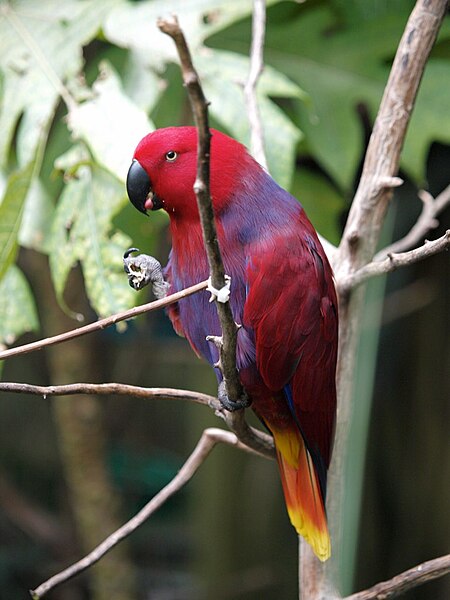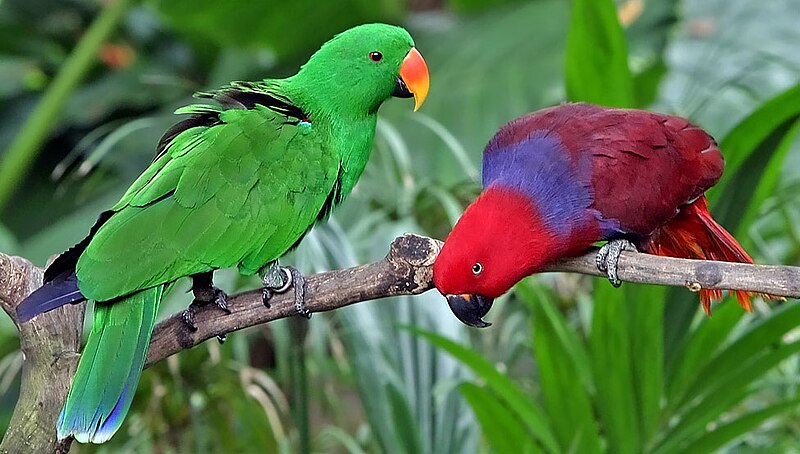In Part I of this article we discussed eclectus parrot (Eclectus roratus) behavior in the wild and captivity. Today I would like to focus on one of the more unusual facets Eclectus Parrot natural history – how a unique reproductive strategy has fostered a degree of sexual dimorphism (difference in appearance between the sexes) unknown among other parrots.
A Study in Contrasts – Sexual Dimorphism
Male and female eclectus parrots vary so much in appearance that they were believed to be different species by the first  Europeans to encounter them in Indonesia. Indeed, few bird species, and no other parrots, exhibit such extreme sexual dimorphism.
Europeans to encounter them in Indonesia. Indeed, few bird species, and no other parrots, exhibit such extreme sexual dimorphism.
Female Eclectus Parrots are stoutly built and sport gorgeous red and vermillion feathers of several shades. Splashes of blue and lavender decorate the breast, and the bill is jet black.
In sharp contrast, males are streamlined in build and a brilliant emerald green in color. Shades of red, blue and yellow are distributed along the sides and wings. The bill of a mature male is decorated in red, orange and yellow.
The feathers of both sexes appear somewhat silky, and are often described as resembling fur, and they seem almost florescent in hue.
Why do the Sexes Differ So?
 Various theories have been proposed to explain the Eclectus’ surprising sexual dimorphism. One relates the phenomenon to the differing life styles of the sexes. During the breeding season, females spend the majority of their days in and near the nesting hole. In their leaf-covered, dimly lit nesting areas, located high in the forest canopy, the deep reds and blues of their feathers blend in well with the shadows falling upon the bark, limbs and leaves.
Various theories have been proposed to explain the Eclectus’ surprising sexual dimorphism. One relates the phenomenon to the differing life styles of the sexes. During the breeding season, females spend the majority of their days in and near the nesting hole. In their leaf-covered, dimly lit nesting areas, located high in the forest canopy, the deep reds and blues of their feathers blend in well with the shadows falling upon the bark, limbs and leaves.
Some ornithologists (bird biologists) believe that the female’s bright red color signals males that she is in possession of a rare and valuable resource – a secure nest site. It seems that a scarcity of suitable nesting holes has led Eclectus Parrots to evolve a breeding strategy unknown among their relatives. Several males may mate with a female who has been lucky enough to secure a nest site that is safe from pythons, monitor lizards and other predators.
Males forage widely and feed the females for much of the year. Their green plumage offers excellent camouflage among sunlit leaves.
Further Reading
For more on captive husbandry, please see our book on Eclectus Parrot Care.
For information on viewing Eclectus Parrots and other tropical birds in the wild, and to hear their calls, please see this link.
Juvenile Male Eclectus and Female Eclectus images referenced from wikipedia and originally posted by snowmanradio
 That Bird Blog – Bird Care and History for Pet Birds
That Bird Blog – Bird Care and History for Pet Birds

 Many consider the eclectus to be the most beautiful of all parrots. In fact, early in their avicultural history folks rarely tried to teach eclectus to speak…surely such a gorgeous bird could not also be a talented mimic.
Many consider the eclectus to be the most beautiful of all parrots. In fact, early in their avicultural history folks rarely tried to teach eclectus to speak…surely such a gorgeous bird could not also be a talented mimic.